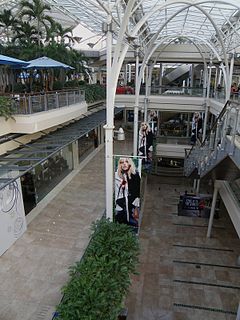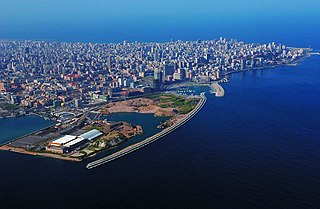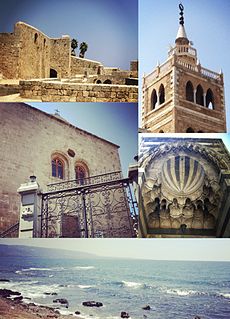
Tripoli is the largest city in northern Lebanon and the second-largest city in the country. Situated 85 kilometers north of the capital Beirut, it is the capital of the North Governorate and the Tripoli District. Tripoli overlooks the eastern Mediterranean Sea, and it is the northernmost seaport in Lebanon. It holds a string of four small islands offshore, and they are also the only islands in Lebanon. The Palm Islands were declared a protected area because of their status of haven for endangered loggerhead turtles, rare monk seals and migratory birds.
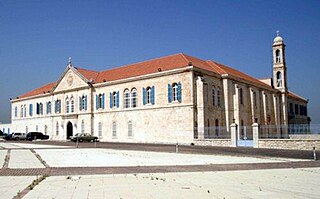
The Maronite Church is an Eastern Catholic sui iuris particular church in full communion with the Pope and the worldwide Catholic Church, with self-governance under the Code of Canons of the Eastern Churches. It is headed by Patriarch Bechara Boutros al-Rahi since 2011. Officially known as the Syriac Maronite Church of Antioch, it is part of Syriac Christianity by liturgy and heritage.

Amioun is the capital of the predominantly Greek Orthodox Koura District in the north of Lebanon.

Môle-Saint-Nicolas is a commune in the north-western coast of Haiti. It is the chief town of the Môle-Saint-Nicolas Arrondissement in the department of Nord-Ouest. Christopher Columbus' first voyage to the Americas landed at the site of what is now Môle-Saint-Nicolas on December 6, 1492. The town received its present name after France gained control of the western part of Hispaniola in 1697.

The Beirut Central District (BCD) or Centre Ville is the name given to Beirut’s historical and geographical core, the “vibrant financial, commercial, and administrative hub of the country.” At the heart of Lebanon’s capital, Beirut Central District (BCD) is an area thousands of years old, traditionally a focus of business, finance, culture and leisure.

The Maronite Catholic Eparchy of Saint Maron of Sydney is an overseas Maronite rite eparchy (diocese) of the Catholic Church in Australia, based in Sydney. In 2010 there were 160,000 members. It is currently ruled by Eparch Anthony Tarabay, OLM.

The St Sergius Orthodox Theological Institute in Paris, France, is a private school of higher education in Orthodox theology, founded in 1925 in conformity with French legislation and the norms of European university education, accredited by the Académie de Paris. The mission of the St. Sergius Institute is to form educated priests and laypeople, intending to serve actively the Orthodox Church and representing it in the ecumenical dialogue, as well as in the religious and cultural life of their own country. It is under the canonical jurisdiction of the Russian Orthodox Exarchate in Western Europe, under the omophorion of the Ecumenical Patriarchate.
Bsous Silk Museum is a silk museum in the town of Bsous near Wadi Chahrour in Lebanon, located around 15 kilometres east of Beirut.
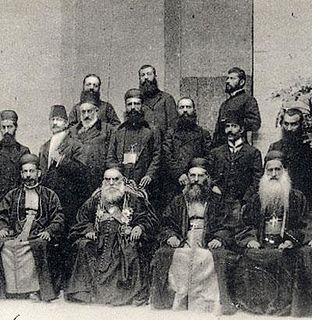
The Maronites are a Christian group who adhere to the Syriac Maronite Church with the largest population around Mount Lebanon in Lebanon. The Maronite Church is an Eastern Catholic sui iuris particular church in full communion with the Pope and the Catholic Church, with self-governance under the Code of Canons of the Eastern Churches, one of more than a dozen individual churches in full communion with the Holy See. They derive their name from the Syriac Christian saint Maron, whose followers migrated to the area of Mount Lebanon from their previous location of residence around the area of Antioch, establishing the nucleus of the Syriac Maronite Church. Some Maronites argue that they are of Mardaite ancestry, but most historians reject such claims. Maronites were able to maintain an independent status in Mount Lebanon and its coastline after the Muslim conquest of the Levant, keeping their Christian religion, and even the distinctive Aramaic language as late as the 19th century.

The Cathedral of St Elias and St Gregory the Illuminator is a cathedral of the Armenian Catholic Church in Debbas Square in downtown Beirut, Lebanon. Construction was funded in 1928 by Pope Pius XI. It is the cathedra of the Armenian Catholic Patriarchate of Cilicia. The order in which the two eponymous saints are presented in the cathedral's name, Saint Elias and Saint Gregory the Illuminator, is not fixed.
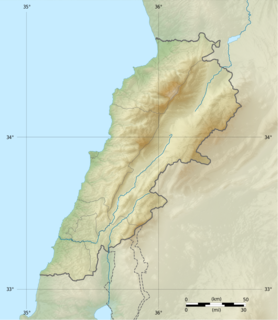
Ras Baalbek I is a rock shelter 500 m (1,600 ft) east of Ras Baalbek in the northern Beqaa Valley in Lebanon. It sits north of the Wadi Teniyet er-Râs valley at a height of 1,000 m (3,300 ft). It was first discovered by Lorraine Copeland and Peter Wescombe in 1965-1966. It was later excavated by Jacques Besançon in 1970. Retouched blades along with a pressure-flaked arrowhead and a burin were found dated to the Neolithic period.
Kelhat (قلحات), Qalhat, Kelhatt, is a Greek Orthodox village in Koura District of Lebanon. It extends from the shores of the Mediterranean Sea to an elevation of around 400m above sea level.

Lebanese Greek Orthodox Christians refers to Lebanese people who are adherents of the Greek Orthodox Church of Antioch in Lebanon, which is an autocephalous Greek Orthodox Church within the wider communion of Eastern Orthodox Christianity, and is the second largest Christian denomination in Lebanon after the Maronite Christians.
The following is a timeline of the history of the city of Beirut, Lebanon.
Lebanese Maronite Christians refers to Lebanese people who are adherents of the Maronite Church in Lebanon, which is the largest Christian denomination in the country.
